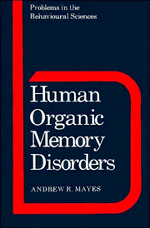Book contents
- Frontmatter
- Contents
- Acknowledgements
- 1 Healthy and pathological memory: the underlying mechanisms
- 2 The assessment of memory disorders
- 3 Disorders of short-term memory
- 4 Disorders of previously well-established memory
- 5 The memory problems caused by frontal lobe lesions
- 6 Organic amnesia
- 7 Animal and biochemical models of amnesia
- 8 Less well-characterized memory disorders
- 9 Overview
- Glossary
- Bibliography
- Index
1 - Healthy and pathological memory: the underlying mechanisms
Published online by Cambridge University Press: 01 June 2011
- Frontmatter
- Contents
- Acknowledgements
- 1 Healthy and pathological memory: the underlying mechanisms
- 2 The assessment of memory disorders
- 3 Disorders of short-term memory
- 4 Disorders of previously well-established memory
- 5 The memory problems caused by frontal lobe lesions
- 6 Organic amnesia
- 7 Animal and biochemical models of amnesia
- 8 Less well-characterized memory disorders
- 9 Overview
- Glossary
- Bibliography
- Index
Summary
Section One: The aims of this book
What were you doing immediately before you picked up this book? This question should cause you little difficulty, but there are people who would find it very hard to answer. For these people, known as organic amnesics, life must be experienced as if they were continually waking from a dream. Brain damage has made them very poor at remembering recently experienced events and at learning new information. It also makes them poor at remembering things that were learnt up to many years prior to the brain trauma. Despite such memory impairments, organic amnesics may have normal or superior intelligence. Not all memory deficits caused by brain damage are like organic amnesia, however. Other patients with lesions different from those responsible for organic amnesia show a very rapid loss of spoken information whilst possessing good longer term remembering of most things. For example, such a person might be unable to repeat back more than two spoken digits even with no delay but be able to give the gist of a newspaper article recounted by someone else on the previous day (something well beyond the powers of an organic amnesic). This kind of short-term memory failure is associated with the language disorder known as conduction aphasia and is clearly distinct from the memory deficits seen in organic amnesia, although both are caused by brain damage.
- Type
- Chapter
- Information
- Human Organic Memory Disorders , pp. 1 - 35Publisher: Cambridge University PressPrint publication year: 1988



